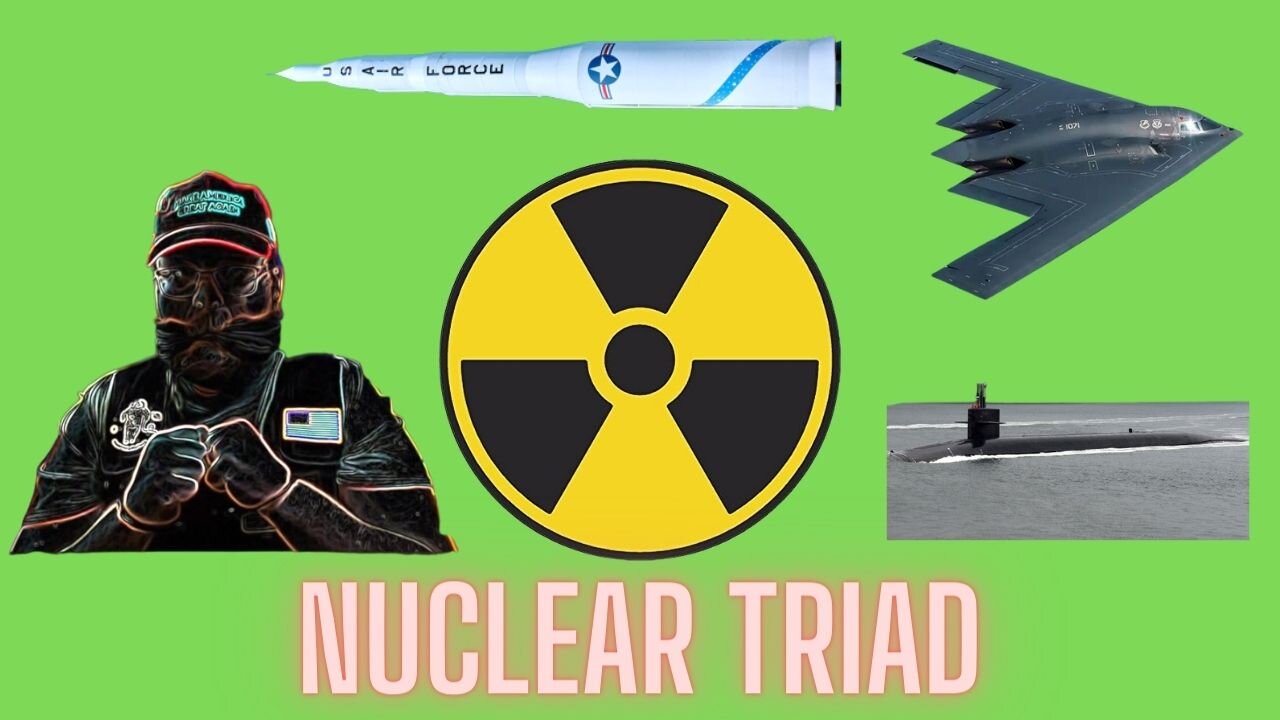Premium Only Content

America's Nuclear Triad - Science and Tech Tuesday
The U.S. nuclear arsenal comprises thousands of nuclear weapons and three methods of delivery, sometimes called “legs.” Warheads can be launched from the air via strategic bombers carrying gravity bombs or cruise missiles, from the sea by submarines holding ballistic missiles, or from underground silos housing intercontinental ballistic missiles. Collectively, these delivery methods are referred to as “the Triad.” Currently all three legs of the Triad are being modernized at a cost of $494 billion, or about $50 billion every year from 2019 to 2028.
The United States has stated it must maintain all three legs of the Triad in order to support the policy of deterrence — the credible threat of retaliation if it or an ally is attacked. The argument is that the Triad enables a second-strike capability — the ability to retaliate in the event of a nuclear attack — as each leg is a hedge against the failure of another.
However, a debate has emerged among lawmakers and policy experts about whether the land-based leg of the Triad is still necessary or desirable. A recent survey found that many Americans support phasing out our land-based missiles because they are “outdated, destabilizing, and very expensive.”
How many?
The United States currently maintains around 5,800 nuclear warheads in its arsenal. Of these, about 3,800 are active warheads and 2,000 have been retired and are awaiting dismantlement. The inventory of deployed delivery systems consists of 66 bombers as well as dual-capable fighter aircrafts; 14 ballistic missile submarines; and 400 silos for intercontinental ballistic missiles.
Air
There are two distinct nuclear weapons systems delivered by plane: nuclear air-launched cruise missiles (ALCMs), which are guided and highly accurate, and gravity bombs, which require a plane to deploy them near a desired target. B-52 bombers carry nuclear-tipped ALCMs and B-2 stealth bombers have gravity bomb capabilities. Currently there are 20 B-2s and 46 B-52s deployed.
The B-2 can carry up to 16 nuclear bombs like the B61-7, B61-11, and B83-1 gravity bombs. Each B-52 bomber carries up to 20 ALCMs like the AGM-86B.
Current nuclear modernization plans include continued production of a new gravity bomb (B61-12) and a new nuclear cruise missile known as the Long Range Standoff Weapon (LRSO). The Air Force is also designing the B-21 “Raider” to replace the B-2 and B-52s, as well as the F-35 to replace the F-16 as the United States’ key nuclear-capable fighter aircraft.
Sea
The sea leg of the Triad currently consists of 14 Ohio-class ballistic missile submarines (SSBNs). These submarines are capable of firing ballistic missiles from submerged positions to hit an intended target. Current U.S. SSBNs can launch up to 20 nuclear-capable ballistic missiles with multiple warheads per missile. The Trident II D5 missile is the latest generation SSBN and can travel more than 7,000 kilometers. The sea leg of the triad is often considered the most essential, since submarines are difficult to track and destroy.
The Ohio-class SSBNs will be replaced by the Columbia-class SSBN in the early 2030s and includes 12 scheduled submarines slotted for production. As of now, this modernization will cost around $109.8 billion.
Ground
The Triad’s land-based leg is composed of 400 deployed Minuteman III intercontinental ballistic missiles (ICBMs). U.S. ICBMs are housed in underground silos in Montana, North Dakota and Wyoming, but silos stretch into Colorado and Nebraska as well. Each ICBM carries one warhead each — usually the W87 or the W78 — but can hold two or three warheads each. ICBMs remain on prompt alert, meaning they can be launched in minutes.
Nuclear modernization plans include a replacement for the Minuteman III called the Ground-Based Strategic Deterrent, and includes 400 new deployed missiles, modernization of the ICBM launch facilities and a total lifetime price tag of about $264 billion.
The static nature of ICBM silos makes them vulnerable to attack and increases the risk of miscalculation. If the United States detects an incoming attack or what looks like an incoming attack, there is psychological pressure to launch the ICBMs before they can be destroyed in their silos — a sort of “use them or lose them” mentality. It is the combination of the vulnerability of ICBMs, the risk of miscalculation and the replacement cost that leads some experts to argue that the United States no longer needs a land-based nuclear weapon system.
-
 10:28
10:28
BlabberingCollector
11 hours agoAsk Blabs, Episode 5 | Answering Your Wizarding World Related Questions
1.17K -
 18:09
18:09
Forrest Galante
5 days agoI Survived 24 Hours In The World's Deadliest Jungle
180K30 -
 LIVE
LIVE
Lofi Girl
2 years agoSynthwave Radio 🌌 - beats to chill/game to
160 watching -
 2:15:09
2:15:09
Badlands Media
15 hours agoOnlyLands Ep. 27: Power Hour Hangover, Trump’s Wartime Shift, and Portland in Flames
104K23 -
 22:21
22:21
DeVory Darkins
5 hours ago $14.96 earnedRioters attack Portland ICE Facility as Democrats make shocking admission
14.3K75 -
 2:06:06
2:06:06
TimcastIRL
8 hours agoTrump DOJ Announces INTERVENTION In Portland Over Nick Sortor Arrest | Timcast IRL
228K366 -
 6:53:58
6:53:58
SpartakusLIVE
9 hours ago#1 All-American HERO with LUSCIOUS hair and AVERAGE forehead brings Friday Night HYPE
65.1K7 -
 3:06:43
3:06:43
Laura Loomer
7 hours agoEP147: Islamic Terror EXPLODES In The West After UK Synagogue Attack
49.1K43 -
 1:02:50
1:02:50
Flyover Conservatives
13 hours agoEric Trump: America’s Most Subpoenaed Man SPEAKS OUT! | FOC Show
43K12 -
 3:36:44
3:36:44
PandaSub2000
1 day agoSuper Mario Galaxy 1 & 2 | ULTRA BEST AT GAMES (Original Live Version)
32.8K3
